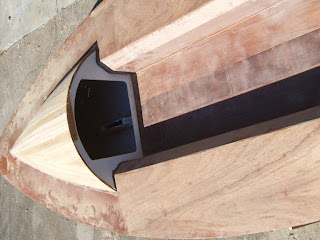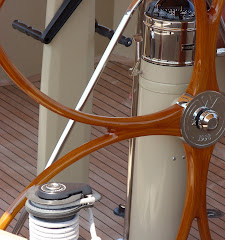I’m trying to think of what was done when and found myself
having to read the blog post to remind me where we left off. There has been
minimum progress but I have no idea of the time so I think I’ll just ballpark
that and we’ll call it up to date.
All the deck and cockpit floor was installed and filleted in
place when we last left but no picture was added at the time so this is the
first pic posted of the completed hull.
I have a few pictures
of on hand of the cabin or coach roof construction to show. It was a simple process using cedar strips approximately
¾” x ¼”. I used a few wider strips to start the center but if I were to do it
again I would opt for the same size strips all the way. I used a staggered pattern
as you can see in the photo and it made laying them in easy enough. They are
glued with standard wood glue to help speed laying it up. This is an acceptable
practice as the whole thing then gets sandwiched between two layers of epoxy
and 4oz. biaxial cloth. The sanding
prior to laying the cloth was done with an orbital sander on the inside and an
orbital and long board sander on the outside. Don’t be afraid to use some 40
grit here as you are shaping the cedar to fair it and it gets the epoxy glass
covers.
Just typing a few lines reenergizes my desire to get things
back on track but we’ll see. Just
getting an hours work on it seems overwhelming right now.
I’ll leave her up for sale in the meantime and see how it
goes.
Time this segment:
We won't count moving across half the country and the time it sat on the trailer in the garage!
Glue up all the deck panels 6 hours
Fillets on all deck panels 3 hours
Laying Cedar Strips 6 hours
Sanding/Fairing inside and outside 6 hours
Glass inside cabin roof 1 hour or less
Total this segment 22 hours
Total Project: 167 hours
We won't count moving across half the country and the time it sat on the trailer in the garage!
Glue up all the deck panels 6 hours
Fillets on all deck panels 3 hours
Laying Cedar Strips 6 hours
Sanding/Fairing inside and outside 6 hours
Glass inside cabin roof 1 hour or less
Total this segment 22 hours
Total Project: 167 hours






















